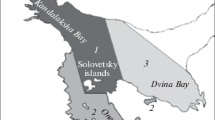Abstract
The Japan sea form of the threespine stickleback, Gasterosteus aculeatus, was found to spawn in the seawater tidal pool of the Cape Benkei, western Hokkaido Island, Japan, in 2001 and 2003. Nest-guarding males, adult females and juveniles of this form were also observed in four tidal pools of the Capes Benkei, Kabuto and Kamui, in 2001–2003. Otolith Sr:Ca ratios in sticklebacks collected from these tidal pools were relative high from the core to the edge, suggesting they lived in seawater environments throughout its life cycle. These findings suggest that a part of the Japan Sea formȁ9s individuals in western Hokkaido Island have the potential to breed in the coastal sea and the life history style has evolved in dependence on the seawater environment.
Similar content being viewed by others
References
Arai T (2002). Migratory history of fishes: present status and perspectives of the analytical methods. Jpn J Ichthyol 49:1–23 (in Japanese with English abstract)
Arai T., Goto A, Miyazaki N (2003a) Use of otolith microchemistry to estimate the migratory history of the threespine stickleback, Gasterosteus aculeatus. J Mar Biol Assoc UK 83:223–230
Arai T, Goto A, Miyazaki N (2003b) Migratory history of the threespine stickleback Gasterosteus aculeatus. Ichthyol Res 50:9–14
Arai T, Otake T, Tsukamoto K (1997) Drastic changes in otolith microstructure and microchemistry accompanying the onset of metamorphosis in the Japanese eel, Anguilla japonica. Mar Ecol Prog Ser 161:17–22
Bańbura J (1994) Lateral plate morph differentiation of freshwater and marine populations of the three-spined stickleback, Gasterosteus aculeatus, in Poland. J Fish Biol 44:773–783
Bell MA, Foster SA (1994) Introduction to the evolutionary biology of the threespine stickleback. In: Bell MA, Foster SA (eds) The evolutionary biology of the threespine stickleback. Oxford University Press, Oxford, pp 1–27
Blouw DM, Hagen DW (1990) Breeding ecology and evidence of reproductive isolation of a widespread stickleback fish (Gasterosteidae) in Nova Scotia, Canada. Biol J Linn Soc 39:195–217
Borg B (1985) Field studies on three-spined sticklebacks in the Baltic. Behaviour 93:153–157
Coad BW, Power G (1973) Observations on the ecology and phenotypic variation of the threespine stickleback, Gasterosteus aculeatus L, (1758), and the blackspotted stickleback, G. wheatlandi Putnam, (1867), (Osteichthyes: Gasterosteidae) in Amory Cove, Québec. Can Field-Nat 87:113–122
Gross MR, Coleman RM, McDowall RM (1988) Aquatic productivity and the evolution of diadromous fish migration. Science 239:1291–1293
Haglund TR, Buth DG, Lawson R (1992) Allozyme variation and phylogenetic relationships of Asian, North American, European populations of the threespine stickleback, Gasterosteus aculeatus. Copeia 1992:432–443
Hamada K (1975) Excessively enlarged thyroid follicles of the threespine stickleback, Gasterosteus aculeatus aculeatus, reared in freshwater. Jpn J Ichthyol 21:183–190
Higuchi M (1996) Genetic structure and morphological, ecological study of threespine stickleback, Gasterosteus aculeatus, around Japan. Ph.D thesis, Hokkaido University, Japan, 134 pp (in Japanese)
Higuchi M, Goto A (1996) Genetic evidence supporting the existence of two distinct species in the genus Gasterosteus around Japan. Environ Biol Fish 47:1–16
Higuchi M, Goto A, Yamazaki F (1996) Genetic structure of threespine stickleback, Gasterosteus aculeatus, in Lake Harutori, Japan, with reference to coexisting anadromous and freshwater forms. Ichthyol Res 43:349–358
Honma Y, Shioda S, Yoshie S (1977) Changes in the thyroid gland associated with the diadromous migration of the threespine stickleback, Gasterosteus aculeatus. Jpn J Ichthyol 24:17–25
Ikeda K (1933) The distribution and the morphological variations of the sticklebacks in Japan. Zool Mag 45:141–173 (in Japanese)
Ishikawa M, Mori S (2000) Mating success and male courtship behaviors in three populations of the threespine stickleback. Behaviour 137:1065–1080
Jones DH, John AWG (1978) A three-spined stickleback, Gasterosteus aculeatus L. from the North Atlantic. J Fish Biol 13:231–236
Kume M, Kitamura T, Takahashi H, Goto A (2005) Distinct spawning migration patterns in sympatric Japan Sea and Pacific Ocean forms of threespine stickleback Gasterosteus aculeatus. Ichthyol Res 52:189–193
Matsui H, Tada R, Oba T (1998) Low-salinity isolation event in the Japan Sea in response to eustatic sea-level drop during LGM: reconstruction based on salinity-balance model. The Quatern Res 37:221–233 (in Japanese with English abstract)
Miller RR, Hubbs CL (1969) Systematics of Gasterosteus aculeatus, with particular reference to intergradation and introgression along the Pacific coast of North America: a commentary on a recent contribution. Copeia 1969:52–69
Mori S (1987) Divergence in reproductive ecology of the three-spined stickleback, Gasterosteus aculeatus. Jpn J Ichthyol 34:165–175
Mori S (1990) Two morphological types in the reproductive stock of three-spined stickleback in Lake Harutori, Hokkaido Island. Environ Biol Fish 27:21–31
Münzing J (1963) The evolution of variation and distributional patterns in European populations of the three-spined stickleback, Gasterosteus aculeatus. Evolution 17:320–332
Peeke HVS, Morgan LE (2000) Behavioral differentiation of adjacent marine and fluvial populations of threespine stickleback in California: a laboratory study. Behaviour 137:1011–1027
Quinne TP, Light JT (1989) Occurrence of threespine sticklebacks (Gasterosteus aculeatus) in the open North Pacific Ocean: migration or drift? Can J Zool 67:2850–2852
Sugisaki T, Honma Y (1981) Thyroid activity of the juvenile threespine stickleback, Gasterosteus aculeatus, reared in different salinities of water. Annu Rep Sado Mar Biol Station, Niigata Univ 11:11–19
Wootton RJ (1984) A functional biology of sticklebacks. Croom Helm, London, 265 pp
Yamada M (2003) Evolutionary process and introgression of mitochondrial DNA in threespine stickleback, Gasterosteus aculeatus, around Japan. Ph.D thesis, Hokkaido University, Japan, 71 pp
Acknowledgements
We thank S. Mori and H. Takahashi for their valuable suggestions and Y. Suzuki for his assistance in sampling. We are also grateful to two anonymous reviewers for critical comments and valuable corrections on this manuscript.
Author information
Authors and Affiliations
Corresponding author
Rights and permissions
About this article
Cite this article
Kume, M., Kuwahara, T., Arai, T. et al. A part of the Japan Sea form of the threespine stickleback, Gasterosteus aculeatus, spawns in the seawater tidal pools of western Hokkaido Island, Japan. Environ Biol Fish 77, 169–175 (2006). https://doi.org/10.1007/s10641-006-9068-6
Received:
Accepted:
Published:
Issue Date:
DOI: https://doi.org/10.1007/s10641-006-9068-6




